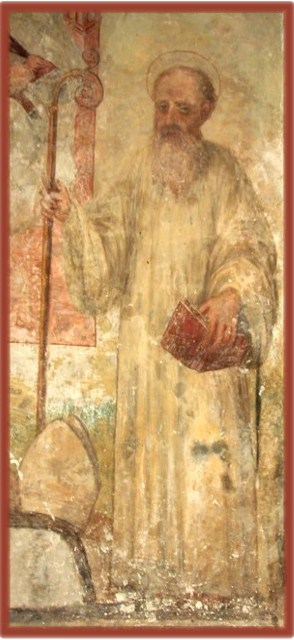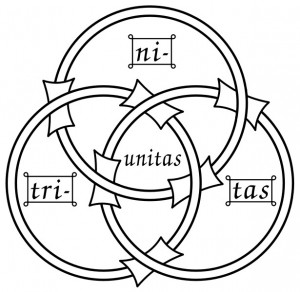A New Epoch, Making the Hierarchy of the Church Unnecessary
Oct 26th, 2011 by admin
The Prophecies of Joachim of Fiore
[Source: Wikipedia]
Born in the small village of Celico near Cosenza in Calabria, at the time part of the Kingdom of Sicily, Joachim was the son of Mauro the notary, who was well placed, and Gemma, his wife. He was educated at Cosenza, where he became first a clerk in the courts, and then a notary himself, and worked in 1166-1167 for Etienne du Perche, archbishop of Palermo and chancellor of Marguerite, regent for the young William II of Sicily.
- Fiore Alfresco in Cathedral Santo Severina
A 1573 fresco depicting Gioacchino da Fiore, in the Cathedral of Santa Severina, Calabria, Italy
About 1159 he went on pilgrimage to the Holy Land, an episode about which very little is known, save that he underwent a spiritual crisis and conversion in Jerusalem that turned him from the worldly life. When he returned, he lived as a hermit for several years, wandering and preaching before joining the ascetic Cistercian Abbey of Sambucina near Luzzi, Calabria, as a lay brother, where he devoted his time to lay preaching. Under pressure from the ecclesiastical authorities, he joined the monks of the Abbey of Corrazo, and was ordained priest, apparently in 1168. He applied himself entirely to Biblical study, with a special view to uncovering the arcane meaning concealed in the Scriptures, above all in Revelation. To his dismay, he was acclaimed abbot by the monks of Corazzo (c. 1177). He then attempted to join the monastery to the Cistercian Order, but was refused because of the community’s poverty. In the winter of 1178, he appealed in person to William II, who granted the monks some lands.
In 1182 Joachim appealed to Pope Lucius III, who relieved him of the temporal care of his abbey, and warmly approved of his work, bidding him continue it in whatever monastery he thought best. He spent the following year and a half at the Cistercian Abbey of Casamari, engaged upon his three great books, his dictations keeping three scribes busy night and day; there the young monk, Lucas (afterwards Archbishop of Cosenza, who acted as his secretary, was amazed to see so famous and eloquent a man wearing such rags, and the wonderful devotion with which he preached and said Mass.
In 1184 he was in Rome, interpreting an obscure prophecy found among the papers of Cardinal Matthew of Angers, and was encouraged by Pope Lucius III. Succeeding popes confirmed the papal approbation, though his manuscripts had not begun to circulate. Joachim retired first to the hermitage of Pietralata, writing all the while, and then founded the Abbey of Fiore (or Flora) in the mountains of Calabria; Flora became the center of a new and stricter branch of the Cistercian Order, approved by Celestine III in 1198.
In 1200 Joachim publicly submitted all his writings to the examination of Innocent III, but died before any judgment was passed. The holiness of his life was widely known: Dante affirmed that miracles were said to have been wrought at his tomb, and, though never officially beatified, he is still venerated as a beatus on May 29.
He theorized the dawn of a new age, based on his interpretation of verses in the Book of Revelation, in which the Church would be unnecessary (which, of course, was considered Heresy) and infidels would unite with Christians. Members of the spiritual wing of the Franciscan order acclaimed him as a prophet.
His popularity was enormous in the period, and some sources hold that Richard the Lionheart wished to meet him to discuss the Book of Revelation before leaving for the Third Crusade.
His famous Trinitarian “IEUE” interlaced circles diagram was influenced by the different 3-circles Tetragrammaton-Trinity diagram of Petrus Alfonsi, and in turn led to the use of the Borromean rings as a symbol of the Christian Trinity (and possibly also influenced the development of the Shield of the Trinity diagram).
Theory of the three ages
The mystical basis of his teaching is his doctrine of the “Eternal Gospel,” founded on an interpretation of the text in Revelation xiv, 6. And I saw another angel fly in the midst of heaven, having the everlasting gospel to preach unto them that dwell on the earth, and to every nation, and kindred, and tongue, and people,
His theories can be considered Millinarian; he believed that history, by analogy with the Trinity, was divided into three fundamental epochs:
- The Age of the Father, corresponding to the Old Testament, characterized by obedience of mankind to the Rules of God;
- The Age of the Son, between the advent of Christ and 1260, represented by the New Testament, when Man became the son of God;
- The Age of the Holy Spirit, impending (in 1260), when mankind was to come in direct contact with God, reaching the total freedom preached by the Christian message. The Kingdom of the Holy Spirit, a new dispensation of universal love, would proceed from the Gospel of Christ, but transcend the letter of it. In this new Age the ecclesiastical organization would be replaced and the Order of the Just would rule the Church. This Order of the Just was later identified with the Franciscan order by his follower Gerardo of Borgo San Donnino.
According to Joachim, only in this third Age will it be possible to really understand the words of God in its deepest meanings, and not merely literally. He concluded that this age would begin in 1260 based on the Book of Revelation (verses 11:3 and 12:6, which mention “one thousand two hundred and sixty days”). In this year, instead of the parousia (second Advent of Christ), a new Epoch of peace and concord would begin, thus making the hierarchy of the Church unnecessary.
[John Hogue, in The Last Pope Revisited comments: Prophecy Scholars estimate that since this Second Era lasted 2,000 years, the advent of the Third Age of the Holy Spirit should manifest any time after the year 2000.]
Joachim distinguished between the “reign of justice” or of “law”, in an imperfect society, and the “reign of freedom” in a perfect society.
Condemnation
Thomas Aquinas confuted his theories in his Summa Theologica, but in The Divine Comedy, Dante placed him in paradise. Among the more spiritually-inclined of the Franciscans, a “Joachite” group arose, many of whom saw Antichrist already in the world in the person of Frederick II, Holy Roman Emperor (who died, however, in 1250). The ‘Doctor Mirabilis’, Roger Bacon, was one of their number.
As the appointed year approached, spurious works began to circulate under Joachim’s name: De Oneribus Prophetarum, an Expositio Sybillae et Merlini (“Exposition of the Sibyl and Merlin”) and commentaries on the prophecies of Jeremiah and Isaiah. The Fourth Council of the Lateran in 1215 condemned some of his ideas about the nature of the Trinity. Finally Pope Alexander IV condemned his writings and those of his follower Gerardo of Borgo Donnino and set up a commission that in 1263 at the Synod of Arles declared Joachim’s theories heretical.
His theories also inspired subsequent heresies like dulcinians and Brethren of the Free Spirit.
The Borromean Rings as a symbol of the Christian Trinity, based on an illustration in a 13th-century French manuscript found at Chartres, as reproduced in Didron’s book, “Christian Iconography” (1843).


